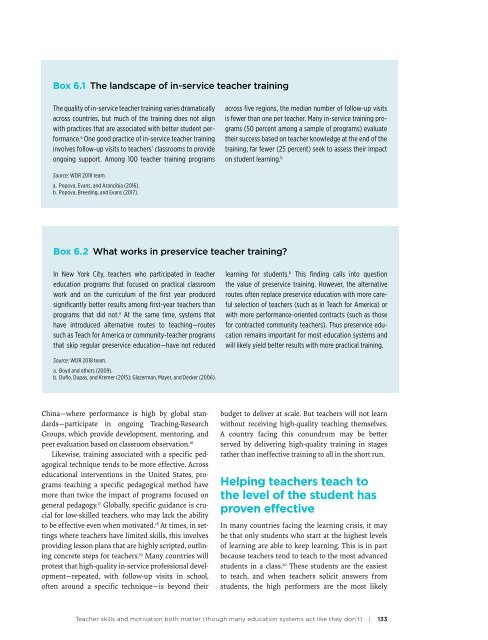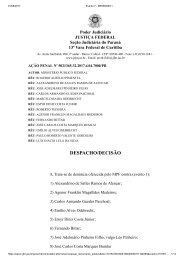Brasil só deve dominar Leitura em 260 anos, aponta estudo do Banco Mundial Relatorio Banco Mundial _Learning
You also want an ePaper? Increase the reach of your titles
YUMPU automatically turns print PDFs into web optimized ePapers that Google loves.
Box 6.1 The landscape of in-service teacher training<br />
The quality of in-service teacher training varies dramatically<br />
across countries, but much of the training <strong>do</strong>es not align<br />
with practices that are associated with better student performance.<br />
a One good practice of in-service teacher training<br />
involves follow-up visits to teachers’ classrooms to provide<br />
ongoing support. Among 100 teacher training programs<br />
across five regions, the median number of follow-up visits<br />
is fewer than one per teacher. Many in-service training programs<br />
(50 percent among a sample of programs) evaluate<br />
their success based on teacher knowledge at the end of the<br />
training; far fewer (25 percent) seek to assess their impact<br />
on student learning. b<br />
Source: WDR 2018 team.<br />
a. Popova, Evans, and Arancibia (2016).<br />
b. Popova, Breeding, and Evans (2017).<br />
Box 6.2 What works in preservice teacher training?<br />
In New York City, teachers who participated in teacher<br />
education programs that focused on practical classroom<br />
work and on the curriculum of the first year produced<br />
significantly better results among first-year teachers than<br />
programs that did not. a At the same time, syst<strong>em</strong>s that<br />
have introduced alternative routes to teaching—routes<br />
such as Teach for America or community-teacher programs<br />
that skip regular preservice education—have not reduced<br />
learning for students. b This finding calls into question<br />
the value of preservice training. However, the alternative<br />
routes often replace preservice education with more careful<br />
selection of teachers (such as in Teach for America) or<br />
with more performance-oriented contracts (such as those<br />
for contracted community teachers). Thus preservice education<br />
r<strong>em</strong>ains important for most education syst<strong>em</strong>s and<br />
will likely yield better results with more practical training.<br />
Source: WDR 2018 team.<br />
a. Boyd and others (2009).<br />
b. Duflo, Dupas, and Kr<strong>em</strong>er (2015); Glazerman, Mayer, and Decker (2006).<br />
China—where performance is high by global standards—participate<br />
in ongoing Teaching-Research<br />
Groups, which provide <strong>deve</strong>lopment, mentoring, and<br />
peer evaluation based on classroom observation. 16<br />
Likewise, training associated with a specific pedagogical<br />
technique tends to be more effective. Across<br />
educational interventions in the United States, programs<br />
teaching a specific pedagogical method have<br />
more than twice the impact of programs focused on<br />
general pedagogy. 17 Globally, specific guidance is crucial<br />
for low-skilled teachers, who may lack the ability<br />
to be effective even when motivated. 18 At times, in settings<br />
where teachers have limited skills, this involves<br />
providing lesson plans that are highly scripted, outlining<br />
concrete steps for teachers. 19 Many countries will<br />
protest that high-quality in-service professional <strong>deve</strong>lopment—repeated,<br />
with follow-up visits in school,<br />
often around a specific technique—is beyond their<br />
budget to deliver at scale. But teachers will not learn<br />
without receiving high-quality teaching th<strong>em</strong>selves.<br />
A country facing this conundrum may be better<br />
served by delivering high-quality training in stages<br />
rather than ineffective training to all in the short run.<br />
Helping teachers teach to<br />
the level of the student has<br />
proven effective<br />
In many countries facing the learning crisis, it may<br />
be that only students who start at the highest levels<br />
of learning are able to keep learning. This is in part<br />
because teachers tend to teach to the most advanced<br />
students in a class. 20 These students are the easiest<br />
to teach, and when teachers solicit answers from<br />
students, the high performers are the most likely<br />
Teacher skills and motivation both matter (though many education syst<strong>em</strong>s act like they <strong>do</strong>n’t) | 133








